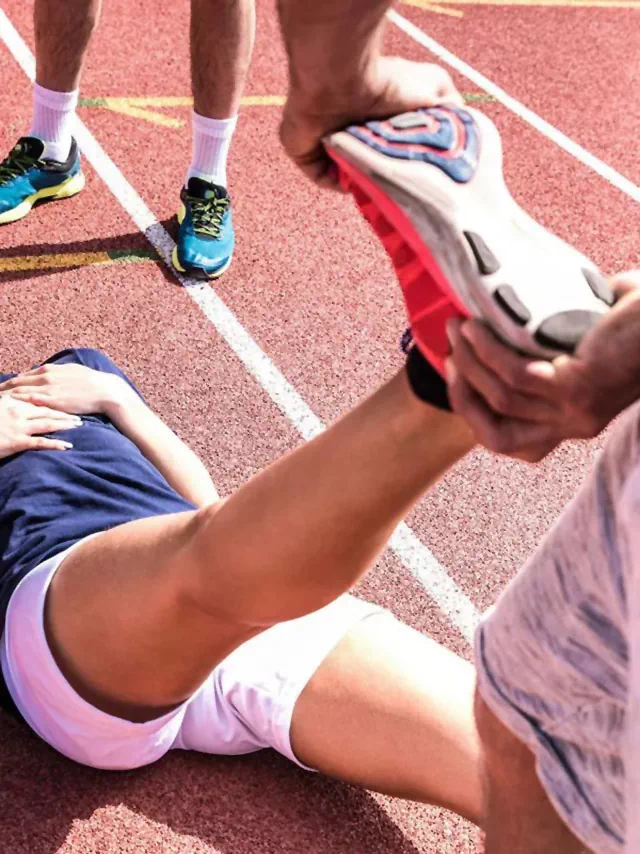A sports cramp is a sudden and involuntary contraction of a muscle that is usually caused by fatigue, dehydration, or muscle strain. It can cause pain and limit the range of motion in the affected area. To treat a cramp, you can try stretching the affected muscle, massaging it, drinking water or electrolyte-rich fluids, and taking over-the-counter pain medication if necessary. To prevent cramps, it’s important to stay hydrated, warm up properly before exercising, and gradually increase the intensity of physical activity.
Muscle cramp
A muscle cramp happens when a muscle contracts suddenly and uncontrollably. These cramps, also called muscle spasms or charley horses, can occur in one or more muscles at a time. They can be painful, but they usually only last from a few seconds to 15 minutes.
Muscle cramps can be a symptom of many different medical issues. They are often associated with muscle strain, but they can also be a sign of medical conditions such as circulation problems and liver disease.
Muscle cramps can interfere with your daily activities. Because they often happen at night, they can affect your sleep. As a result, they may reduce your quality of life. But in most cases, muscle cramps are not serious.
Causes of muscle cramps
Doctors do not always know what causes a muscle cramp. When your healthcare provider can’t find a specific cause, the cramps are called idiopathic. There are actually many different medical disorders that can cause this symptom. Conditions and circumstances that may cause muscle cramps include:
Aging
Over time, losing muscle mass can put more strain on your muscles. These changes can lead to more frequent muscle cramps as you age.
Dehydration
Losing body fluids while exercising (especially in hot temperatures) can cause muscles to cramp.
Hypothyroidism
Having a thyroid gland that is less active than normal can lead to muscle cramps.
Low electrolyte levels
Low levels of substances such as calcium or potassium in the blood can cause muscle cramps.
Medication
Taking certain medicines, including pseudoephedrine (a drug used to treat nasal congestion) and statins (medications that treat high cholesterol), can cause involuntary muscle cramping.
Nerve disorders
In rare cases, issues such as a pinched nerve or spinal cord injury can cause nerve compression (pressure on nerves), which can lead to muscle cramps.
Physical strain
Overusing your muscles during exercise or strenuous activities can lead to cramps.
Pregnancy
Often, women who are pregnant experience leg cramps due to low electrolyte levels, circulation changes, and pressure on the nerves caused by the growing baby.
Tight muscles
Inactivity and not enough stretching can cause muscles to contract (clench) involuntarily.
How long it last?
The duration of a sports cramp can vary, but most cramps last from a few seconds to several minutes. In some cases, cramps can persist for hours or even days, especially if they are caused by an underlying medical condition. If a cramp lasts for an extended period of time or is accompanied by swelling, redness, or other symptoms, it is advisable to seek medical attention.
How to get rid of cramps in sports?
There are several steps you can take to help prevent cramps during sports:
Hydrate properly
Make sure to drink enough water before, during, and after physical activity.Proper hydration practices help reduce the risk of dehydration and heat illness, and improve performance during exhaustive exercise,” says Heather Mangieri, a sports and wellness dietitian in Pittsburgh and author of “Fueling Young Athletes.
Warm up properly
Do a proper warm-up before engaging in any physical activity to prepare your muscles for exercise.Warming up before physical activity can help prevent cramps by increasing blood flow to the muscles and preparing them for exertion. This can also reduce the risk of injury. Examples of a good warm-up include light cardio, stretching, and dynamic movements specific to the upcoming activity.
Stretch
Stretch your muscles regularly, especially after physical activity, to maintain flexibility.Stand facing a wall and stretch out your arms until your hands can just touch it. Make sure you are able to stand up straight and that your feet are flat on the floor. Lean forward, pressing your hands against the wall until you feel your calf muscles stretch. Hold for 2 or 3 seconds.
Proper nutrition
Eat a balanced diet with enough carbohydrates, protein, and electrolytes to support your athletic performance.
Gradual increase in intensity
Gradually increase the intensity of your physical activity to help your body adjust and prevent cramping.
Massage
Massaging the affected muscle can help relieve cramping.
Get enough rest
Make sure to get enough sleep and rest between physical activity sessions to allow your muscles to recover.




